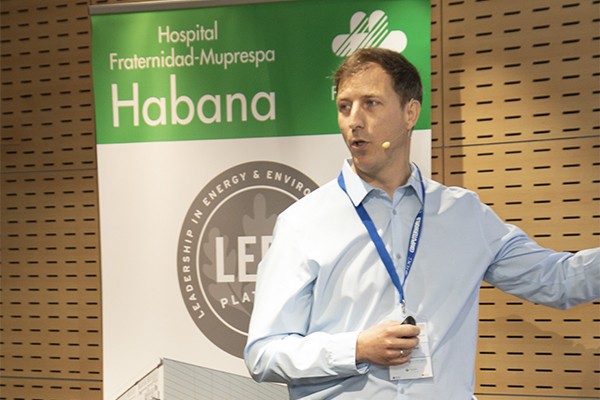Digital transformation in healthcare and artificial intelligence: progress and success stories

To celebrate the opening of Havana’s Fraternidad Muprespa Paseo Hospital, one of the world’s handful of LEED-certified hospitals, its assembly hall has hosted IT Health, an event at which GMV has spoken about its in radiotherapy, surgical-planning and navigation developments.
Carlos Illana, Product Manager of radiance and leader of the NAVIPHY project, ran through the history of radiotherapy in cancer treatment, focusing on current-day advances fueled by application of this technique in the operating theater itself, in other words, intraoperative radiation therapy (IORT). As it stands today, Illana pointed out, “60% of cancers are cured and this figure is expected to rise to 70% by 2030”. He stressed the crucial role played by clinicians in the development of healthcare products like radiance, GMV’s inhouse IORT planning software. “We GMV engineers first started working closely with clinicians over 15 years now, when we developed our knee arthroscope simulator”. This liaison is essential “to keep track of their real needs and come up with the right technological response”.
He also explained the healthcare impact of the surgical navigation module radiance in terms of improving the precision of breast cancer treatment. This progress has been achieved in collaboration with the Doctor Negrín Hospital, whose IORT service is European leader thanks largely to the unstinting efforts of Professor Pedro Lara, who expressed his firm conviction about “the payback of healthcare technology investments, both for the system and for patients”. Some of the main goals that GMV’s digital healthcare engineers have been working towards are to achieve greater precision in tumor removal and to provide surgeons, radiation oncologists and radiotherapy physicians with technological tools for digitalizing operating theaters with certainty and higher success rates.
Because, as the neurosurgeon of the Hospital Universitario la Paz, Marisa Gandía explained, in about fifteen years “we have progressed from carrying out surgery “by eye”, documenting the procedure by hand, with reports such as “macroscopically complete surgery”, then moving on to “complete microscopy” and finally, with the application of technology, to “ultrasound-controlled navigator-guided surgery”.
The digital journey, in combination with artificial intelligence, impinges on two fundamental aspects of healthcare organizations: the work of clinicians and the work of managers. Both of them are sine qua nons of success in the necessary cultural change for bringing the healthcare sector up to the level of others like banking. A recent study by the World Intellectual Property Organization shows that half of the 340,000 AI patent applications made throughout history were submitted between 2013 and 2016. The report concludes that AI has now moved on from the theoretical field to the world market and it picks out medical science as an area with the biggest technology takeup.
One healthcare AI application success story is the project of the Consellería de Sanidade (Healthcare Ministry) of the Xunta (Regional Authority) of Galicia, which has brought to light over one thousand cases of rare diseases using a GMV-developed epidemiological and clinical data mining platform. The famous 5 P's of medicine (predictive, preventive, personalized, participatory, and purpose-driven) has now moved on from the field of theory to practice, with patients/clients to the fore. After all, as the participants at this event unanimously agreed, today’s increasingly informed patients are now demanding experiences to match those they already enjoyed in other sectors.